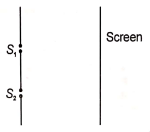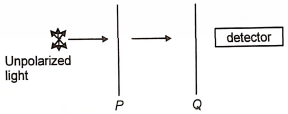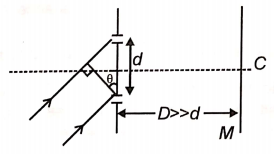In Young’s double slit experiment, the slits are 2 mm apart and are illuminated by photons of two wavelength λ1 = 12000 Å and λ2 = 10000 Å. At what minimum distance from the common central bright fringe on the screen 2 m from the slit will a bright fringe from one interference pattern coincide with a bright fringe from the other?
1. 6 mm
2. 4 mm
3. 3 mm
4. 8 mm
2. 4 mm
3. 3 mm
4. 8 mm

To unlock all the explanations of 14 chapters you need to be enrolled in MasterClass Course.

To unlock all the explanations of 14 chapters you need to be enrolled in MasterClass Course.
A parallel beam of fast-moving electrons is incident normally on a narrow slit. A fluorescent screen is placed at a large distance from the slit. If the speed of the electrons is increased, which of the following statements is correct?
| 1. | The angular width of the central maximum of the diffraction pattern will increase. |
| 2. | The angular width of the central maximum will decrease. |
| 3. | The angular width of the central maximum will be unaffected. |
| 4. | A diffraction pattern is not observed on the screen in the case of electrons. |

To unlock all the explanations of 14 chapters you need to be enrolled in MasterClass Course.

To unlock all the explanations of 14 chapters you need to be enrolled in MasterClass Course.
Which colour of light has the longest wavelength?
1. violet
2. red
3. blue
4. green

To unlock all the explanations of 14 chapters you need to be enrolled in MasterClass Course.

To unlock all the explanations of 14 chapters you need to be enrolled in MasterClass Course.
In a double-slit experiment, when light of wavelength 400 nm was used, the angular width of the first minima formed on a screen placed 1 m away, was found to be 0.2. What will be the angular width of the first minima, if the entire experimental apparatus is immersed in water?
1. 0.1
2. 0.266
3. 0.15
4. 0.05

To unlock all the explanations of 14 chapters you need to be enrolled in MasterClass Course.

To unlock all the explanations of 14 chapters you need to be enrolled in MasterClass Course.
In YDSE like an experiment, the intensity of light from both slits is the same and the interference pattern is observed along a screen parallel to the plane of and . If D, B, A represents the location of a minimum, a maximum, and a point where intensity is the average intensity and is the fringe width and DB, BA, and DA represent the minimum separations, then DB, BA, and DA are:

1.
2.
3.
4.
In Young's double-slit experiment conducted in a liquid, the 10th bright fringe in liquid lies where the 6th dark fringe lies in a vacuum. The refractive index of the liquid approximately is:
1. 1.82
2. 1.54
3. 1.67
4. 1.20

To unlock all the explanations of 14 chapters you need to be enrolled in MasterClass Course.

To unlock all the explanations of 14 chapters you need to be enrolled in MasterClass Course.
In the optical arrangement as shown below, the axes of two polarizing sheets P and Q are oriented such that no light is detected. Now when a third polarizing sheet (R) is placed in between P and Q, then the light is detected. Which of the following statement(s) is(are) false?

1. Polarization axes of P and Q are perpendicular to each other
2. The polarization axis of R is not parallel to P
3. The polarization axis of Ris not parallel to Q
4. Polarization axes of P and Q are parallel to each other

To unlock all the explanations of 14 chapters you need to be enrolled in MasterClass Course.

To unlock all the explanations of 14 chapters you need to be enrolled in MasterClass Course.
A diffraction pattern is obtained using a beam of blue light. What happens if the blue light is replaced by red light?
1. No change
2. Diffraction bands become narrower and crowded together
3. Bands become broader and farther apart
4. Bands disappear

To unlock all the explanations of 14 chapters you need to be enrolled in MasterClass Course.

To unlock all the explanations of 14 chapters you need to be enrolled in MasterClass Course.
In YDSE, when a thin transparent sheet of thickness t and refractive index = 1.5 is placed just in front of the upper slit, the central bright fringe shifts to the nth bright fringe. Then n is [ wavelength of light in the air]
1.
2.
3.
4.

To unlock all the explanations of 14 chapters you need to be enrolled in MasterClass Course.

To unlock all the explanations of 14 chapters you need to be enrolled in MasterClass Course.
In YDSE, refer to figure, d >> and . The central bright fringe is obtained at distance x above Point C, then x is:

1.
2.
3. 2D
4. Zero

To unlock all the explanations of 14 chapters you need to be enrolled in MasterClass Course.

To unlock all the explanations of 14 chapters you need to be enrolled in MasterClass Course.






